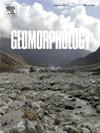华南黄土高原全新世土壤侵蚀对气候变率的响应
IF 3.1
2区 地球科学
Q2 GEOGRAPHY, PHYSICAL
引用次数: 0
摘要
土壤侵蚀是世界干旱半干旱地区面临的一个重大环境挑战,气候与土壤侵蚀之间的关系受到了广泛关注。研究长期的环境变化将有助于更准确地量化这种关系。本文通过对米卢村、五方和祁山三个代表性黄土古土壤剖面的地层、理化和微形态资料的分析,重建了黄土高原南部全新世土壤水分和侵蚀的历史。研究结果将全新世划分为5个地层单元:2个古土壤层(S01和S02)和3个黄土层(L0、Lx和Lt),每个层反映了季风模式、沙尘暴活动、温度和降水变化的阶段。值得注意的是,在中全新世早期古土壤S02形成期间,平均气温约为15.1°C,年降水量为808 mm,其中东亚夏季风贡献了约450 mm,超过了非季风源的约360 mm。在S02中,次生粘土矿物和茂密的木根痕迹的发展,以及粘土矿物含量的变化,表明8500年至6000年前土壤湿度升高。这种水分可能维持了重力水,促进了土壤水分的积极平衡,并支持了茂密的森林植被。研究表明,间冰期和间冰期由于植被覆盖较好,土壤侵蚀较弱,而冰期和间冰期土壤侵蚀加剧。一个明显的例子是6000至5000年前的Lx地层,在此期间,严重的侵蚀导致高原大部分地区的薄黄土层流失。本文章由计算机程序翻译,如有差异,请以英文原文为准。
Holocene soil erosion in response to climate variability in the southern Chinese Loess Plateau
Soil erosion is a major environmental challenge in arid and semi-arid regions of the world, and the relationship between climate and soil erosion has received considerable attention. Looking into long-term environmental variability would help quantify this relationship more accurately. New stratigraphical, physical-chemical, and micromorphological data from three representative loess-palaeosol sections—Milucun, Wufang, and Qishan—have been analysed to reconstruct the Holocene history of soil moisture and erosion in the southern Chinese Loess Plateau. The findings divide the Holocene into five stratigraphical units: two palaeosol (S01 and S02) and three loess layers (L0, Lx, and Lt), each reflecting a stage of monsoon patterns, sandstorm activity, temperature, and precipitation changes. Notably, during the formation of the early mid-Holocene palaeosol S02, average temperature was around 15.1 °C with annual precipitation of 808 mm, of which the East Asian summer monsoon contributed approximately 450 mm, surpassing non-monsoon sources of ca. 360 mm. The development of secondary argillans and dense woody root traces within S02, alongside shifts in clay mineral content, suggest elevated soil moisture between 8500 and 6000 years ago. This moisture likely sustained gravitational water, fostering a positive soil moisture balance and supporting lush forest vegetation. This study proposes that interglacials and interstadials experienced weaker soil erosion due to better vegetation cover, while glacials and stadials saw intensified erosion. A clear example is the Lx formation between 6000 and 5000 years ago, during which significant erosion led to the loss of this thin loess layer in much of the plateau.
求助全文
通过发布文献求助,成功后即可免费获取论文全文。
去求助
来源期刊

Geomorphology
地学-地球科学综合
CiteScore
8.00
自引率
10.30%
发文量
309
审稿时长
3.4 months
期刊介绍:
Our journal''s scope includes geomorphic themes of: tectonics and regional structure; glacial processes and landforms; fluvial sequences, Quaternary environmental change and dating; fluvial processes and landforms; mass movement, slopes and periglacial processes; hillslopes and soil erosion; weathering, karst and soils; aeolian processes and landforms, coastal dunes and arid environments; coastal and marine processes, estuaries and lakes; modelling, theoretical and quantitative geomorphology; DEM, GIS and remote sensing methods and applications; hazards, applied and planetary geomorphology; and volcanics.
 求助内容:
求助内容: 应助结果提醒方式:
应助结果提醒方式:


